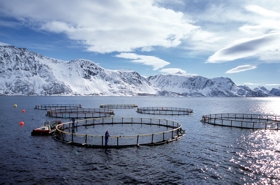Welcome to AquaCase
Introduction
 AquaCase is a portal designed to provide you with information about different types of aquaculture facilities
and related information, how they are built up, and how they operate.
The purpose is to create a virtual tour of the facilities in order to provide much of the information you would get from a field trip.
AquaCase is a portal designed to provide you with information about different types of aquaculture facilities
and related information, how they are built up, and how they operate.
The purpose is to create a virtual tour of the facilities in order to provide much of the information you would get from a field trip.
In an educational context, this is meant as a supplement to traditional classroom teaching. The published material will also be used as background information for assignments as needed.
At present, this resource provides farm cases from Norway (Salmon smolt hatchery), Sweden (ongrowing facility for Arctic Charr), Italy (sea bream fry and commercial size sea bream and sea bass), Finnland (production of sturgeon roe), Germany (production of whiteleg shrimp), Greece (mussel culture), Italy (cooperative management in clam farming in Emilia Romagna region in Italy), Malawi (indoor tilapia hatchery), Portugal (seaweed farming), edible aquatic plant production from South-East Asia, Indonesia (large-scale tilapia production in Lake Toba) and a farm case on rearing of Siamese Fighting Fish from Malaysia. More cases are expected to be introduced soon.
Apart from the farm cases, the resource provides tutorials for learning activities, from simple instructions to a complete template for an online course in aquaculture and many more, aquaculture related literature and relevant links.
Navigation
The site currently has about 140 pages, divided into seven main categories and navigating this site is easy:
- Hatcheries
- Ongrowing
- Mussels
- Aquatic plants
- Shrimps
- Country information
- Learning activities
- Other resources
 Using the navigation tabs at the top of the page, you will find the list of cases under these categories.
Once you have chosen a case, each case will be divided into 5 sections accessible via the navigation tabs:
Using the navigation tabs at the top of the page, you will find the list of cases under these categories.
Once you have chosen a case, each case will be divided into 5 sections accessible via the navigation tabs:
- Introduction: provides a general introduction to the farm case.
- The site: This section contains information about the site and the conditions that affect the facility and its operation.
- Facility and equipment: Provides a more detailed description of the facility and the equipment used.
- Planning and operation: This section describes the general production plan and the operation of the facility.
- Local community: This section provides information about the local community around the site.
- Recipes (selected resources): if applicable, this resource provides some encouragement how to prepare the products from the related production of the farm case.
 You can at any point see where you have navigated with the "You are here" overview at the top of the page. You can then click anywhere to navigate back.
You can at any point see where you have navigated with the "You are here" overview at the top of the page. You can then click anywhere to navigate back.
To scroll directly to the subheadings you are interested in, you can use the quickjump bubble on the right. Should you want to return to the top of the page, simply click the "back to top" icon next to each subheading.
Media content
Some sections might make additional materials available to you, such as documents, Internet links, photos and videos and guidance to case-related learning activities. If applicable, a table like the one below is shown with appropriate links to the materials.
|
|
|
|
|
|
|
|
|
Acknowledgements
We would like to thank the following colleagues and companies for making their facilities available and supporting in the creation of AquaCase:
- Mowi (Compilation by Odd Ivar Lekang and Mikkel Mowinkel)
- Salmar (Compilation by Odd Ivar Lekang and Mikkel Mowinkel)
- Umlax (Compilation by Odd Ivar Lekang and Mikkel Mowinkel)
- Valle Ca’ Zuliani (Compilation by Maria Messina and Bernd Ueberschär)
- Carelia Caviar (Compilation by Juhani Pirhonen and Bernd Ueberschär)
- ALGAPLUS(Compilation by Helena Abreu and Sónia Seixas and Bernd Ueberschär)
- Green Aqua Farming (Compilation by Bernd Ueberschär)
- Tilapia Indoor Hatchery, Malawi (Compilation by Bernd Ueberschär)
- Production of Edible Aquatic Plants (Compilation by William Leschen and Bernd Ueberschär)
- Aie Betta Lover Farm (Compilation by Pamela Ernstberger and Bernd Ueberschär)
- PT Aquafarm Nusantara (Compilation by John Bostock and Bernd Ueberschär and courtesy of Regal Springs)
- BioServe, Bernd Ueberschär (various contributions and overall responsibility)
- Cooperative Management in Clam farming in Emilia Romagna region in Italy (Compilation by Pamela Ernstberger)
Furthermore, we wish to thank Norways Open Universities (Norgesuniversitetet) for their support in the initialization of the project and Aqua-tnet for supporting the further development until 2016. The EURASTiP (the European Asian aquaculture Technology and innovation Platform) has provided financial resources in 2019 to extent AquaCase specifically by farm cases and information about aquaculture in South-East Asia.
Support
If you have any questions or queries regarding this website, find a mistake or have ideas for improvements, please contact Odd Ivar Lekang or Bernd Ueberschär